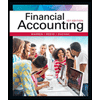
a
Concept Introduction: The allowance method records
The estimated balance of allowance for doubtful accounts assuming the company uses 4.5% of total accounts receivable as uncollectible, instead of the aging of receivable.
b
Concept Introduction: The allowance method records bad debts by matching them with estimated losses from uncollectible accounts receivable. The allowance method requires the estimation of total bad debt expected from sales during the period. This method is better than direct write-off because it records estimated bad debts expense for the period of sales and it reports the estimated amount of cash collected from accounts receivable in the balance sheet.
The year-end
c
Concept Introduction: The allowance method records bad debts by matching them with estimated losses from uncollectible accounts receivable. The allowance method requires the estimation of total bad debt expected from sales during the period. This method is better than direct write-off because it records estimated bad debts expense for the period of sales and it reports the estimated amount of cash collected from accounts receivable in the balance sheet.
The year-end adjustment entry to record bad debts assuming allowance for a doubtful account has an unadjusted balance of $1,000 debit.
Want to see the full answer?
Check out a sample textbook solution
Chapter 7 Solutions
FINANCIAL AND MANAGERIAL ACCOUNTING
- Can you help me find the accurate solution to this financial accounting problem using valid principles?arrow_forwardJazz Corporation owns 50 percent of the Vanderbilt Corporation stock. Vanderbilt distributed a $10,000 dividend to Jazz Corporation. Jazz Corporation's taxable income before the dividend was $100,000. What is the amount of Jazz's dividends received deduction on the dividend it received from Vanderbilt Corporation?arrow_forwardHow can I solve this financial accounting problem using the appropriate financial process?arrow_forward
- I am searching for the accurate solution to this general accounting problem with the right approach.arrow_forwardPlease provide the correct answer to this general accounting problem using valid calculations.arrow_forwardBillie Bob purchased a used camera (five-year property) for use in his sole proprietorship in the prior year. The basis of the camera was $2,400. Billie Bob used the camera in his business 60 percent of the time during the first year. During the second year, Billie Bob used the camera 40 percent for business use. Calculate Billie Bob’s depreciation deduction during the second year, assuming the sole proprietorship had a loss during the year. (Billie Bob did not place the asset in service in the last quarter.arrow_forward
- According to the income tax of Jamaica, a person is a resident if he (a) lives in the country, (b) resides in the country for not more than 183 days, (c) lives in a country 183 days or longer in any one year, or (d) lives in a country for 3 consecutive months in any one year.arrow_forwardHiarrow_forwardI need help with accountingarrow_forward
- General accountingarrow_forwardSolvearrow_forwardA local bakery sells 12,000 loaves of sourdough bread each year. The loaves are ordered from an outside supplier, and it takes 4 days for each shipment of loaves to arrive. Ordering costs are estimated at $18 per order. Carrying costs are $6 per loaf per year. Assume that the bakery is open 300 days a year. What is the maximum inventory of loaves held in a given ordering cycle? Solutionarrow_forward
 Financial AccountingAccountingISBN:9781305088436Author:Carl Warren, Jim Reeve, Jonathan DuchacPublisher:Cengage Learning
Financial AccountingAccountingISBN:9781305088436Author:Carl Warren, Jim Reeve, Jonathan DuchacPublisher:Cengage Learning Financial And Managerial AccountingAccountingISBN:9781337902663Author:WARREN, Carl S.Publisher:Cengage Learning,
Financial And Managerial AccountingAccountingISBN:9781337902663Author:WARREN, Carl S.Publisher:Cengage Learning, Financial AccountingAccountingISBN:9781337272124Author:Carl Warren, James M. Reeve, Jonathan DuchacPublisher:Cengage Learning
Financial AccountingAccountingISBN:9781337272124Author:Carl Warren, James M. Reeve, Jonathan DuchacPublisher:Cengage Learning- Principles of Accounting Volume 1AccountingISBN:9781947172685Author:OpenStaxPublisher:OpenStax College
 College Accounting, Chapters 1-27AccountingISBN:9781337794756Author:HEINTZ, James A.Publisher:Cengage Learning,
College Accounting, Chapters 1-27AccountingISBN:9781337794756Author:HEINTZ, James A.Publisher:Cengage Learning,





